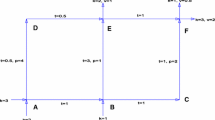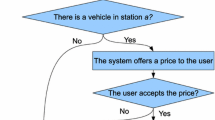Abstract
The main aim of this paper is to show how a new type of sufficient conditions can be used to prove uniqueness of a SUE model with non-separable arc cost-flow functions, even when their Jacobian is asymmetric and non-positive semi-definite. This apparently unusual setup for an assignment model permits to improve the representation of congestion in urban networks. Indeed, the supply models allowed by the standard uniqueness conditions, such as the monotonicity of separable cost-flow functions, can lack realism and thus may lead to wrong decision in the planning process. Actually, the main source of delay suffered by drivers when links are short is intersections, where vehicle flows conflict, competing to use the capacity of links ahead (merging), or are held back by other vehicles that are queuing (diversion). These traffic phenomena do not either lead to separable functions, or to symmetric Jacobians. A suitable supply model is then proposed to which the extended sufficient conditions are applied, showing that the uniqueness of the stochastic equilibrium can be proved also for more realistic volume-delay functions derived from traffic flow theory.







Similar content being viewed by others
References
Beckmann M, McGuire C, Winston C (1956) Studies in the economics of transportation. Yale University Press, New Haven
Bellei G, Gentile G, Papola N (2002) Network pricing optimization in multi-user and multimodal context with elastic demand. Transp Res B 36:779–798
Bellei G, Gentile G, Papola N (2005) A within-day dynamic traffic assignment model for urban road networks. Transp Res B 39:1–29
Bertsekas D (1995) Non-linear programming. Athena Scientific, Belmont
Bliemer M, Brederode L, Wismans L, Smits E (2012) Quasi-dynamic network loading: adding queuing and spillback to static traffic assignment. In: Presented at TRB 2012 Annual Meeting
Cantarella GE (1997) A general fixed-point approach to multi-mode multi-user equilibrium assignment with elastic demand. Transp Sci 31:107–128
Cantarella GE (2002) Condizioni di unicità dei flussi e dei costi di equilibrio stocastico. In: Cantarella G, Russo F (eds) Metodi e Tecnologie dell’Ingegneria dei Trasporti. Seminario 2000, Franco Angeli, Milano, Italy, pp 376–391
Cantarella GE, Cascetta E (2009) Basic and advanced static models for traffic assignment to transportation networks. In: Cascetta E (ed) Transportation Systems Analysis, Chap 5, 6. Springer, Berlin
Cantarella GE, Velonà P (2009) SUE: conditions for solution uniqueness and MSA-based algorithm convergence. In: Rossi R, Della Lucia L, Gastaldi M (eds) Proceedings of the XIII Meeting of the Euro Working Group on Transportation. Padova University Press, Padua
Cantarella GE, Velonà P (2010) Assegnazione a reti di trasporto: modelli di punto fisso. Collana Trasporti, Franco Angeli, Milano, Italy
Cantarella GE, Gentile G, Velonà P (2010) Uniqueness of Stochastic User Equilibrium. In Proceedings of the 5th IMA conference on mathematics in transportation, London, UK
Daganzo CF (1983) Stochastic network equilibrium with multiple vehicle types and asymmetric, indefinite link cost Jacobians. Transp Sci 17:282–300
Daganzo CF (1994) The cell transmission model, part II: network traffic. Transp Res B 28:279–293
Daganzo CF, Sheffi Y (1977) On stochastic models of traffic assignment. Transp Sci 11:253–274
Dial R (2006) A path-based user-equilibrium traffic assignment algorithm that obviates path storage and enumeration. Transp Res B 40:917–936
Gentile G (2000) Il problema di progetto di rete in contesto multiutente, multimodo e a domanda elastica. PhD thesis, Università di Roma “La Sapienza”, Roma, Italy
Gentile G (2003) Sufficient conditions for the uniqueness of the solution to the Stochastic User Equilibrium problem. Technical Report, Università di Roma “La Sapienza”, Roma, Italy
Gentile G (2010a) The General Link Transmission Model for Dynamic Network Loading and a comparison with the DUE algorithm. In: Immers LGH, Tampere CMJ, Viti F (eds) New developments in transport planning: advances in Dynamic Traffic Assignment. Transport Economics, Management and Policy Series. Edward Elgar Publishing, Northampton
Gentile G. (2010b) Traffic assignment: can dynamic models offer more? In: Martin U et al. (eds) Proceedings of Networks for Mobility, 5th International Symposium, FOVUS, Stuttgart Germany
Gentile G. (2012) Local User Cost Equilibrium: a bush-based algorithm for traffic assignment. Transportmetrica. doi:10.1080/18128602.2012.69191
Gentile G, Meschini L, Papola N (2007) Spillback congestion in dynamic traffic assignment: a macroscopic flow model with time-varying bottlenecks. Transp Res B 41:1114–1138
Kellogg RB (1976) Uniqueness in the Schauder fixed point theorem. In: Proceedings of the American Mathematical Society, vol 60, pp 207–210
Khamsi MA, Kirk WA (2001) An introduction to metric spaces and fixed point theory. Wiley, New York
Meschini L, Gentile G (2010) Real-time traffic monitoring and forecast through OPTIMA—optimal path travel information for mobility actions. In: Fusco G (eds) Proceedings of Models and Technologies for Intelligent Transportation Systems, International Conference Rome 2009, Aracne Rome, Italy, pp 113–121
Newell GF (1982) Applications of queueing theory, 2nd edn. Chapman and Hall, London
Newell GF (1993) A simplified theory on kinematic waves in highway traffic, Part II: queuing at freeway bottlenecks. Transp Res B 27:289–303
Patriksson M (1994) The traffic assignment problem: models and methods. VSP, Utrecht
Powell WB, Sheffi Y (1982) The convergence of equilibrium algorithms with predetermined step sizes. Transp Sci 16:45–55
Author information
Authors and Affiliations
Corresponding author
Appendix 1: Notation table
Appendix 1: Notation table
Fixed point formulation of SUE | |
N | Set of network nodes |
A ⊆ N × N | Set of network arcs |
|A| | Number of arcs in the network |
f a | Flow (volume) of arc a∈A; f a = ∑ od∈D ∑ k∈Kod h k ×b ak |
c a | Cost (generalized) of arc a∈A |
f | (|A| × 1) vector of arc flows; f = B×h |
c | (|A| × 1) vector of arc costs; c = c(f) |
n | Vector of network parameters (e.g. arc capacities, free flow travel times, …) |
ca(f; n), c = c(f) | Non-separable arc cost function |
D ⊆ N × N | Set of demand od couples |
d od | (Positive) demand flow from origin o∈N to destination d∈N, od∈D |
K od | (Non-empty) set of elementary paths connecting o∈N to d∈N, od∈D |
U k | Utility of path k∈K od (random variable) |
p k | Probability of path k∈K od ; Pr[U k ≥ U j ,∀ j∈K od ] |
v k | Systematic utility of path k∈K od ; v k = E[U k ] |
ε k | Random residual of path k∈K od ; ε k = U k − v k |
p k (v j , ∀ j∈K od ) | Choice probability function of the generic path k∈K od |
θ od | Parameter of the Logit model for the origin–destination couple od∈D |
w k | Cost (generalized) of path k∈K od ; w k = ∑ a∈A ca×b ak |
b ak | b ak = 1, if path k∈K od includes arc a, while b ak = 0, otherwise |
K = ∪ od∈D K od | Set of od paths |
B | (|A| × |K|) arc-path incidence matrix, with generic element b ak |
w | (|K| × 1) vector of the generalized costs; w = B T×c |
h k | Flow of path k∈K od ; h k = d od ×p k |
h | (|K| × 1) vector of path flows |
h = h(w) | Demand function; h k = d od ×p k (−w j , ∀ j∈K od ), ∀ k∈K od and od∈D |
d | (|D| × 1) vector of demand flows |
Δ | (|D| × |K|) od-path incidence matrix, with generic element β(k∈K od ) |
S h | Set of feasible path flows; S h = {h∈ℜ|K|: Δ×h = d, h ≥ 0} |
f = f(c) | Network loading map; f(c) = B×h(B T×c) |
S f | Set of feasible arc flows; S f = {f∈ℜ|A|: f = B×h, h∈S h } |
w = w(h) | Supply function; w(h) = B T×c(B×h) |
S c | Set of feasible arc cost vectors; S c = {c∈ℜ|A|: c = c(f), f∈S f } |
β(x) | β(x) = 1, if x is true, while β(x) = 0, otherwise |
Uniqueness conditions of SUE | |
≽ (≼) 0 | Applied to a square matrix, means that it is positive (negative) semi-definite |
≻ (≺) 0 | Applied to a square matrix, means that it is positive (negative) definite |
||M|| | Norm of square matrix M |
λmax(M) | Largest eigenvalue of square matrix M |
n = |K|-|D| | (Number of) reduced travel alternatives (or independent routes) |
I − | Obtained from the identity matrix I |K| by removing the rows corresponding to the last path of each od pair |
I° | Obtained from the identity matrix I |K| by removing the rows corresponding to all paths but the last path of each od pair |
L | Space reduction matrix; L T = I −×(I |K| − Δ T×I°) |
A(x) | Opposite of the demand function Jacobian in the reduced space of travel alternatives; A(x) = −I −×Jac[h(I −T×x)]×I −T |
m | Network dimension parameter; m = λ max((B×L)T×(B×L)) |
α | Positive scalar that added to the diagonal of the arc cost function Jacobian makes it positive definite |
Static queue model | |
T | Duration of the demand peak (demand over capacity) |
T 2 | Duration of the congested period |
e a | Effective capacity of arc a∈A |
q a | Capacity of arc a∈A |
g a | Green split of arc a∈A |
π a | Priority of arc a∈A |
ψ a | Reserved capacity to arc a∈A |
s a | Sending flow of arc a∈A |
Volume delay function | |
l a | Length of arc a∈A |
σ a | Free flow speed of arc a∈A |
j a | Jam density of arc a∈A |
ω a | Jam wave speed of arc a∈A |
γ a | Shape factor of the fundamental diagram of arc a∈A |
δ a | Fixed intersection delay of arc a∈A |
χ a | Signal cycle (0, if there is no signal) of arc a∈A |
Rights and permissions
About this article
Cite this article
Gentile, G., Velonà, P. & Cantarella, G.E. Uniqueness of stochastic user equilibrium with asymmetric volume-delay functions for merging and diversion. EURO J Transp Logist 3, 309–331 (2014). https://doi.org/10.1007/s13676-013-0042-0
Received:
Accepted:
Published:
Issue Date:
DOI: https://doi.org/10.1007/s13676-013-0042-0




